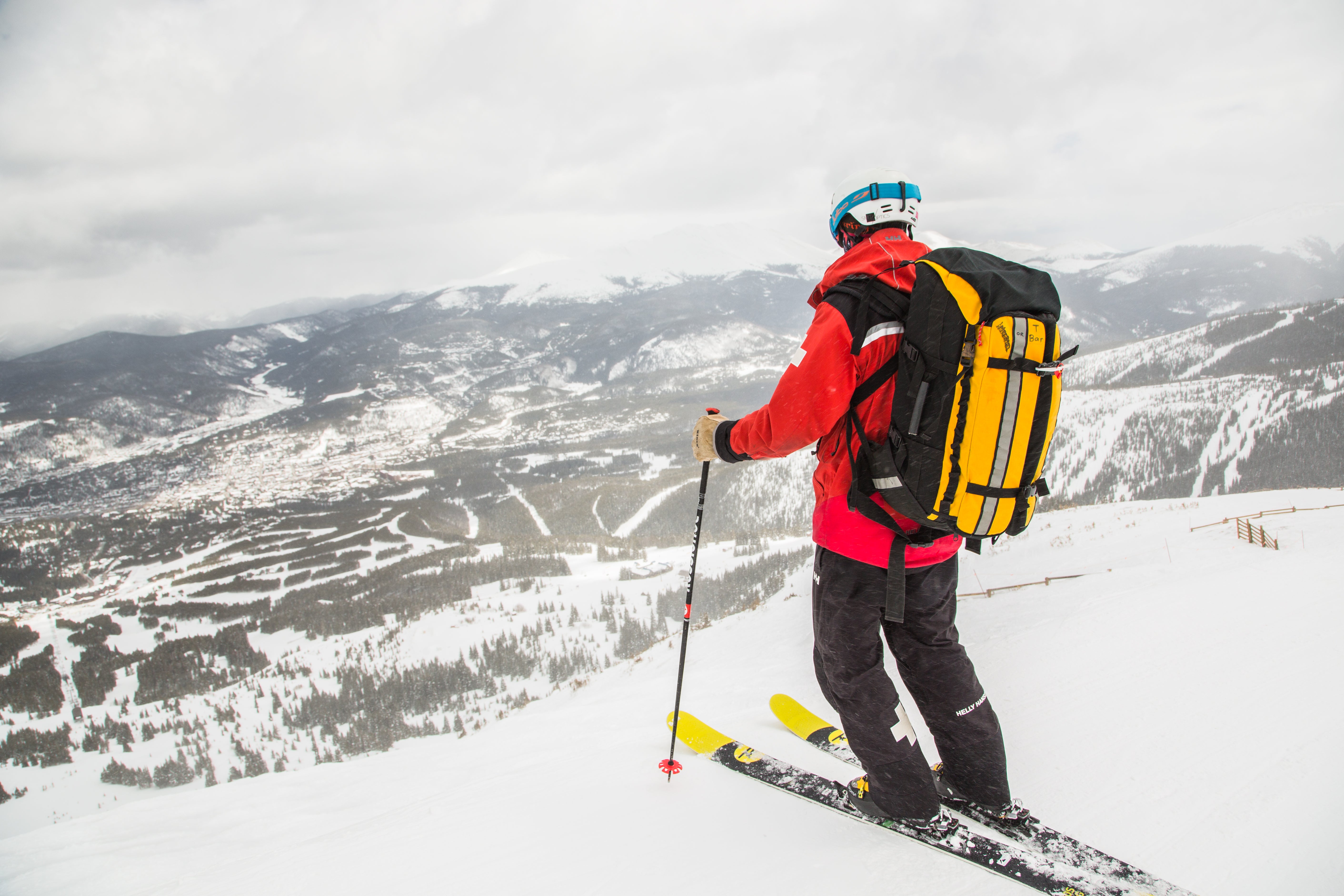Ambulances on Their Backs

BRECKENRIDGE SKI PATROLLER HUNTERMortensen says it never fails. The instant patrol responds to someone seriously sick or injured on the hill, a doctor skis by. “They want to help but they’re used to perfect light and perfect conditions,” Mortensen says. “Then they see me on my hands and knees managing an airway and they ski away.” And, luckily for the on-slope patient, Mortensen has what he likes to call “an ambulance in his backpack.” He’s used to starting IVs, stabilizing vitals, and initiating other invasive medical procedures that were formerly restricted to emergency rooms—on the side of a ski run. Mortensen is part of a bigger movement, mostly invisible to happily obvious skiers, to raise the level of on-hill medical care.
The overarching ski-patrol medical directive used to be to stabilize on-hill patients, pack them into a sled, and get them—fast—to a traditional care facility. But as the sophistication of transportable medical technology improves, and, as Mortensen says, a certain old boys’ club fades out, patrollers are able to offer more-care and change the fate of people who get sick or hurt on the hill. “That’s been the big shift in patrolling in the past 10 or 15 years,” he says. “We’re all at least EMTs and we had a level of training that we weren’t using. There’s no reason we can’t give pre-hospital-level care, and we know that we can impact their recovery.”
On the hill, that care can manifest in a lot of different ways. Mortensen says Breck patrollers can do a needle decompression of the chest wall for a collapsed lung and use an automated external defibrillator during cardiac arrest. They administer drugs to keep patients comfortable, but they’re also hyperaware of how quickly they should transport people and where to send them. When injuries get life-and-death serious, patrol is an increasingly crucial link in the Emergency Medical Services (EMS) chain. “You could say that it’s better to get hurt in a ski area than at your house. We very well could get to you faster than an ambulance,” Mortensen says while showing a guest the patrol’s medical facilities at Breckenridge’s midmountain Vista Haus lodge.
Breckenridge, with its Vail Resort– funded medical budget, has a lot of advantages, including a level-four trauma facility at the base. But smaller hills are trying to advance their level of care too.
Jeff Kaplan, a surgeon and volunteer ski patroller at Bear Valley, Calif., says his team is trying to extend its range of care, but it’s working with a different set of constraints. “Bear is the greatest secret in the West,” he says. “It’s the greatest skiing, but there are no amenities—we’re running on a shoestring. Last year we won the NPS award for the best small patrol, but our budget is tiny and the closest hospital is an hour away by ground.”
Kaplan has patrolled at Bear Valley for four years, and he says that when he first showed up the first-aid supplies consisted of gauze, some slings, cardboard boxes, and wire splints. “There was aspirin and Motrin, but the patients had to administer it themselves,” he says. Along with the mountain’s medical director, Joe Morgensen, another volunteer patroller who is also a retired internal-medicine doctor, he’s worked to augment the supplies the patrollers can provide, and to help them smarten up in how they use them.
For instance, because their budget is small, they’ve asked patients to donate money after they’ve had medical care. “People don’t think twice about paying for it if you suture them up, then ask them to make a donation,” Morgensen says. He’s also adamant that patrollers need to be thinking about the bigger picture of medical care, especially when transportation time is long. “The level of care off the hill makes all the difference in treatment,” Kaplan says. “What’s down the road at the next decision point impacts how you give care. It’s pretty stressful when you have someone who is really unstable and you’re waiting for the ambulance to show up.”
Breckenridge and Bear take different approaches because there’s no industry standard for ski-patrol medical care. Ski patrol is a part of the EMS system, but that can differ county by county, and patrols depend on their individual medical directors to set the directives. “We have to work under a doctor, and ours is really great—he skis all the time. We’ve known him for 25 years. At a lot of other areas, the docs have come and gone,” Mortensen says. “We’re pushing pretty hard to be at the forefront of what we do, but a lot of it comes down to politics.”
That forefront involves supplies, treatment protocols, and getting patients off the hill. Patrols obsessively check out what other resorts are doing to see if it might make sense for them. “Aspen Highlands, for instance, has a fairly aggressive pain-medicines program,” Mortensen says. “They’re adopting strategies from the military field. In combat, the injured receive ketamine [an anesthetic], so now some ski areas give ketamine. These are the conversations we have and are having with our doc.”
What’s more, the focus on critical care reflects changes that are happening industry-wide. “The old boys’ club of the ski industry, with their ‘This is how we’ve done it, this is how we’ve always done it, suck it up and get in my toboggan’ attitude, has gone by the wayside,” Mortensen says. “Now we can offer a ton of free services. We were Obamacare way before there was Obamacare.”